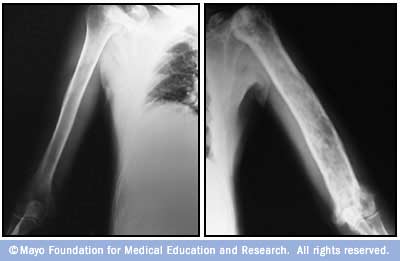Paget’s disease of the bone - symptoms and treatment

Paget’s disease of the bone is a rare and sometimes hereditary condition in which the process of BONE remodeling sporadically accelerates. The new bone that forms to replace old bone has increased mass, enlarging the bone structure, though is weaker than normal bone. Paget’s disease of the bone affects bones randomly throughout the body. Most often affected are the spine, hips, legs, and cranium (skull). Paget’s disease of the bone is more common in people over age 40 and affects men and women about equally. Some researchers believe Paget’s disease of the bone is genetic and other researchers believe a VIRUS activates it.
Symptoms of Paget’s disease of the bone and Diagnostic Path
It is not uncommon for someone to be unaware he or she has Paget’s disease of the bone until several bone fractures occur. Other people have obvious abnormalities of the spine, bowed legs, and moderate to severe JOINT PAIN and bone pain. When there is family history of Paget’s disease of the bone the doctor may look in that direction for diagnosis. When there is not, doctors tend to first explore more common causes for similar symptoms (such as OSTEOPOROSIS). The diagnostic path then becomes circuitous, and diagnosis may take quite some time.
BLOOD tests to measure the presence of an enzyme, alkaline phosphatase, suggest a disorder of bone growth when the enzyme is present. Alkaline phosphatase levels in the body rise whenever there is new bone growth activity. Though not diagnostically conclusive, elevated alkaline phosphatase further points in the direction of Paget’s disease of the bone. COMPUTED TOMOGRAPHY (CT) SCAN and MAGNETIC RESONANCE IMAGING (MRI) can show the extent to which the dysfunctional remodeling affects bones throughout the body. The pattern of bone damage is characteristic.
Paget’s disease of the bone Treatment Options and Outlook
Treatment for Paget’s disease of the bone targets both bone loss and symptoms such as pain. Medications to slow bone resorption (osteoclast activity) help retain more normal bone structure. Among these medications are CALCITONIN and the bisphosphonates (alendronate, clodronate, etidronate, pamidronate, risedronate, and tiludronate). ANALGESIC MEDICATIONS and NONSTEROIDAL ANTI-INFLAMMATORY DRUGS (NSAIDS), in over-thecounter or prescription products, may be necessary to relieve pain.
Risk Factors and Preventive Measures
The primary risk factor for Paget’s disease of the bone is a family history, known or suspected, of the condition. Though there are no measures to prevent Paget’s disease of the bone, early diagnosis offers the best opportunity to mitigate bone loss and other symptoms.
See also BONE CANCER; CALCIUM AND BONE HEALTH; GENETIC DISORDERS; OSTEOGENESIS IMPERFECTA; OSTEOMALACIA.
Open discussion on the topic Paget’s disease of the bone - symptoms and treatment
Similar interests
- Casino Non Aams
- Nuovi Casino
- Casinos Not On Gamstop
- UK Casinos Not On Gamstop
- Casinos Not On Gamstop
- UK Casinos Not On Gamstop
- Casino Non Aams Italia
- Slot Sites Not On Gamstop
- Meilleur Casino En Ligne
- Non Gamstop Casino Sites UK
- Meilleur Casino En Ligne
- Casino En Ligne France
- Best Non Gamstop Casinos
- Casinos Not On Gamstop
- UK Casino Not On Gamstop
- Casinos Not Signed Up To Gamstop
- Best Slot Sites UK
- Non Gamstop Casino Sites UK
- Online Casinos Nederland
- Online Casinos Nederland
- Casinos Not On Gamstop
- Best New Uk Casinos Not On Gamstop
- Casino Non Aams
- Non Gamstop Casinos UK
- Migliori Siti Casino Non Aams
- Bitcoin Casinos
- Sites De Paris Sportifs Belgique
- Bookmaker Non Aams
- Casino En Ligne
- Casino Nouveau En Ligne